Business Administration: Problem Solving and Improvement Report
VerifiedAdded on 2020/11/23
|14
|4013
|482
Report
AI Summary
This report delves into the core principles of business administration, emphasizing problem-solving and continuous improvement methodologies. It begins by explaining various problem-solving techniques, such as abstraction, analogy, and brainstorming, and then explores organizational and legal constraints that impact problem resolution. The report highlights the crucial role of stakeholders, including customers, employees, and investors, in the problem-solving process. It outlines the key steps in business decision-making, including identifying goals, gathering information, considering consequences, making decisions, and evaluating outcomes. Furthermore, the report examines the purpose and benefits of continuous improvement, analyzing techniques like Total Quality Management (TQM) and Lean manufacturing, while also addressing their features, uses, and constraints. It emphasizes the significance of feedback from customers and other stakeholders in driving improvements. The report then identifies the nature, causes, and implications of quality-related problems, evaluates their scope, and proposes actionable solutions. It concludes by discussing the importance of developing plans, obtaining approvals, taking corrective actions, and evaluating the success of implemented solutions. Throughout, the report underscores the importance of evidence-based justification, stakeholder engagement, and adherence to standard operating procedures for achieving continuous improvement in business operations.
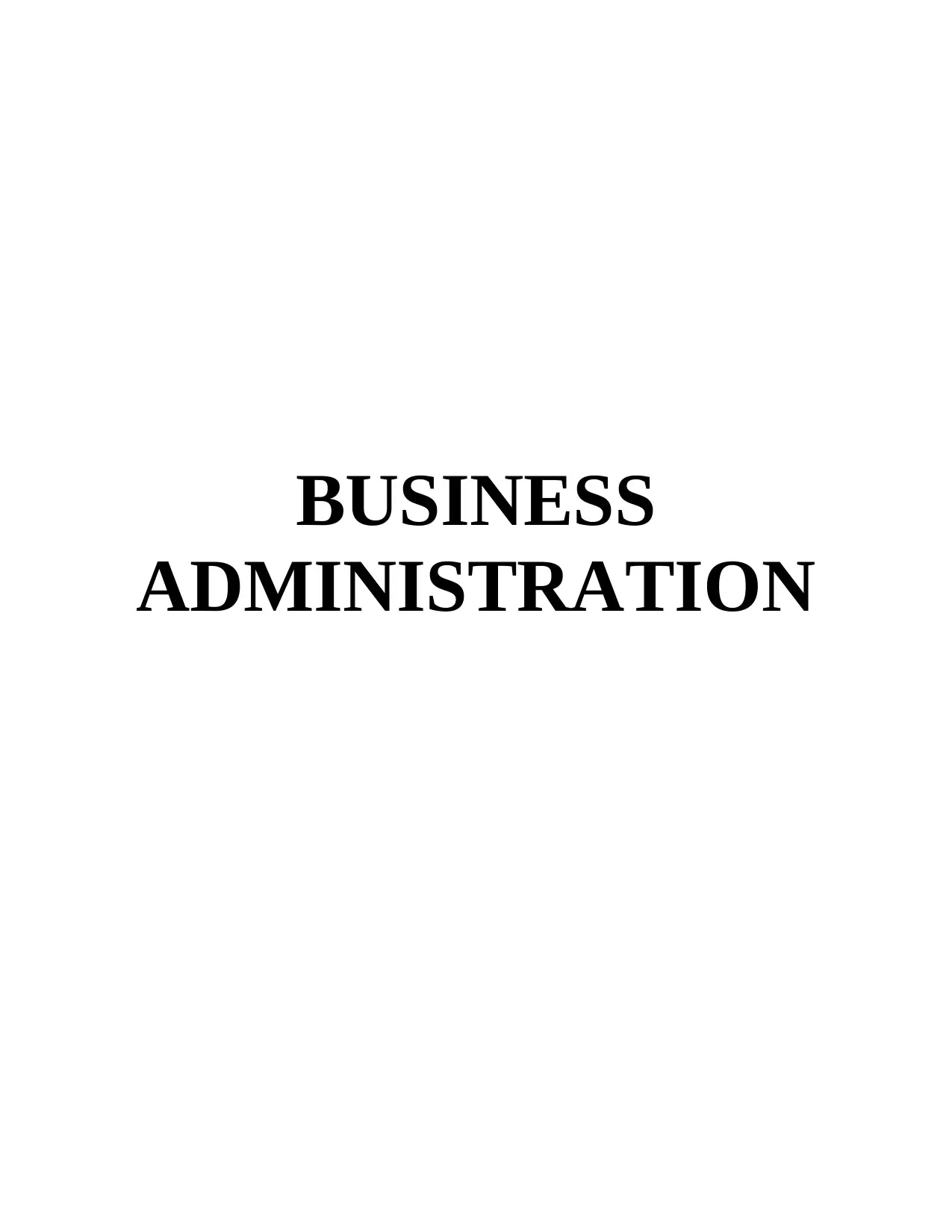
BUSINESS
ADMINISTRATION
ADMINISTRATION
Paraphrase This Document
Need a fresh take? Get an instant paraphrase of this document with our AI Paraphraser
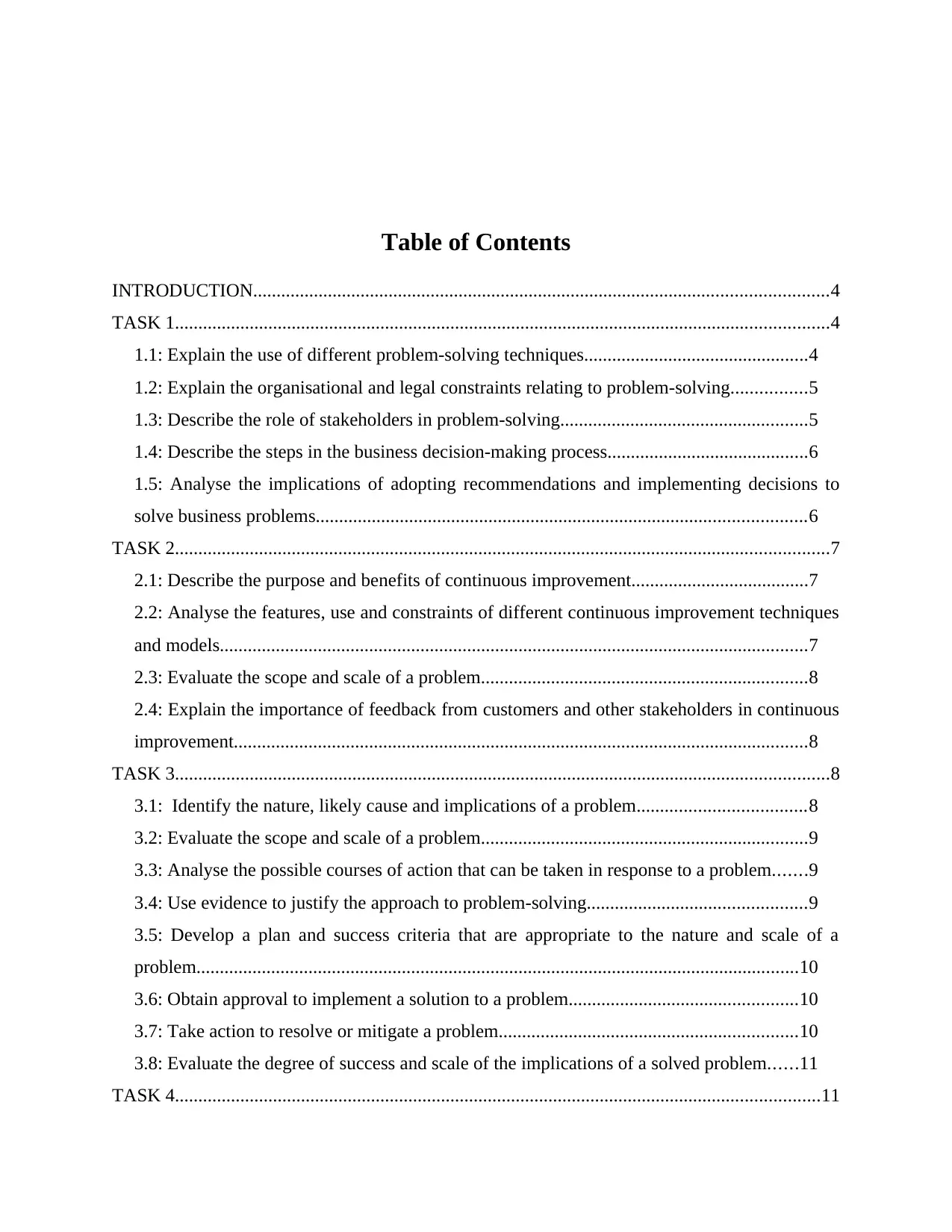
Table of Contents
INTRODUCTION...........................................................................................................................4
TASK 1............................................................................................................................................4
1.1: Explain the use of different problem-solving techniques................................................4
1.2: Explain the organisational and legal constraints relating to problem-solving................5
1.3: Describe the role of stakeholders in problem-solving.....................................................5
1.4: Describe the steps in the business decision-making process...........................................6
1.5: Analyse the implications of adopting recommendations and implementing decisions to
solve business problems.........................................................................................................6
TASK 2............................................................................................................................................7
2.1: Describe the purpose and benefits of continuous improvement......................................7
2.2: Analyse the features, use and constraints of different continuous improvement techniques
and models..............................................................................................................................7
2.3: Evaluate the scope and scale of a problem......................................................................8
2.4: Explain the importance of feedback from customers and other stakeholders in continuous
improvement...........................................................................................................................8
TASK 3............................................................................................................................................8
3.1: Identify the nature, likely cause and implications of a problem....................................8
3.2: Evaluate the scope and scale of a problem......................................................................9
3.3: Analyse the possible courses of action that can be taken in response to a problem.......9
3.4: Use evidence to justify the approach to problem-solving...............................................9
3.5: Develop a plan and success criteria that are appropriate to the nature and scale of a
problem.................................................................................................................................10
3.6: Obtain approval to implement a solution to a problem.................................................10
3.7: Take action to resolve or mitigate a problem................................................................10
3.8: Evaluate the degree of success and scale of the implications of a solved problem......11
TASK 4..........................................................................................................................................11
INTRODUCTION...........................................................................................................................4
TASK 1............................................................................................................................................4
1.1: Explain the use of different problem-solving techniques................................................4
1.2: Explain the organisational and legal constraints relating to problem-solving................5
1.3: Describe the role of stakeholders in problem-solving.....................................................5
1.4: Describe the steps in the business decision-making process...........................................6
1.5: Analyse the implications of adopting recommendations and implementing decisions to
solve business problems.........................................................................................................6
TASK 2............................................................................................................................................7
2.1: Describe the purpose and benefits of continuous improvement......................................7
2.2: Analyse the features, use and constraints of different continuous improvement techniques
and models..............................................................................................................................7
2.3: Evaluate the scope and scale of a problem......................................................................8
2.4: Explain the importance of feedback from customers and other stakeholders in continuous
improvement...........................................................................................................................8
TASK 3............................................................................................................................................8
3.1: Identify the nature, likely cause and implications of a problem....................................8
3.2: Evaluate the scope and scale of a problem......................................................................9
3.3: Analyse the possible courses of action that can be taken in response to a problem.......9
3.4: Use evidence to justify the approach to problem-solving...............................................9
3.5: Develop a plan and success criteria that are appropriate to the nature and scale of a
problem.................................................................................................................................10
3.6: Obtain approval to implement a solution to a problem.................................................10
3.7: Take action to resolve or mitigate a problem................................................................10
3.8: Evaluate the degree of success and scale of the implications of a solved problem......11
TASK 4..........................................................................................................................................11
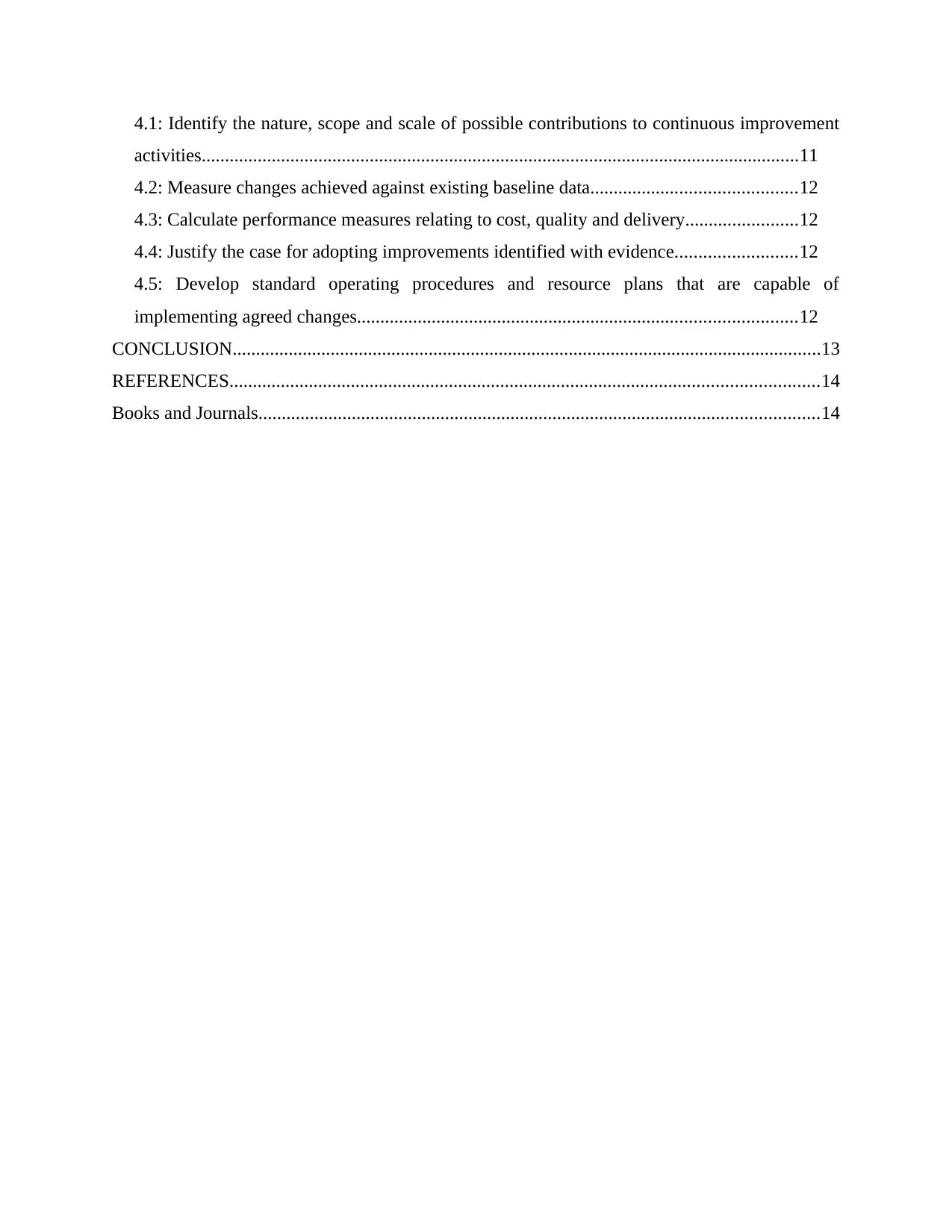
4.1: Identify the nature, scope and scale of possible contributions to continuous improvement
activities................................................................................................................................11
4.2: Measure changes achieved against existing baseline data............................................12
4.3: Calculate performance measures relating to cost, quality and delivery........................12
4.4: Justify the case for adopting improvements identified with evidence..........................12
4.5: Develop standard operating procedures and resource plans that are capable of
implementing agreed changes..............................................................................................12
CONCLUSION..............................................................................................................................13
REFERENCES..............................................................................................................................14
Books and Journals........................................................................................................................14
activities................................................................................................................................11
4.2: Measure changes achieved against existing baseline data............................................12
4.3: Calculate performance measures relating to cost, quality and delivery........................12
4.4: Justify the case for adopting improvements identified with evidence..........................12
4.5: Develop standard operating procedures and resource plans that are capable of
implementing agreed changes..............................................................................................12
CONCLUSION..............................................................................................................................13
REFERENCES..............................................................................................................................14
Books and Journals........................................................................................................................14
⊘ This is a preview!⊘
Do you want full access?
Subscribe today to unlock all pages.

Trusted by 1+ million students worldwide
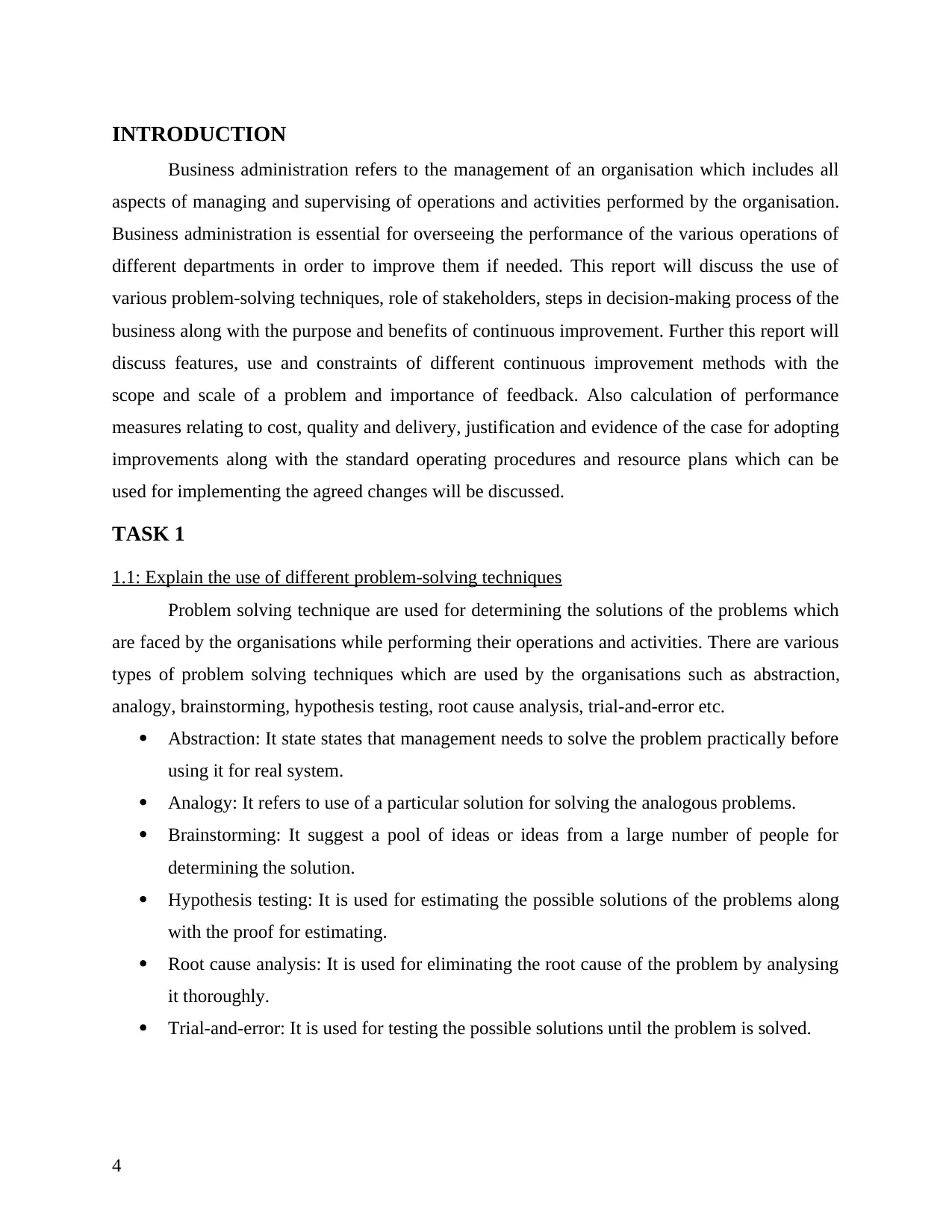
INTRODUCTION
Business administration refers to the management of an organisation which includes all
aspects of managing and supervising of operations and activities performed by the organisation.
Business administration is essential for overseeing the performance of the various operations of
different departments in order to improve them if needed. This report will discuss the use of
various problem-solving techniques, role of stakeholders, steps in decision-making process of the
business along with the purpose and benefits of continuous improvement. Further this report will
discuss features, use and constraints of different continuous improvement methods with the
scope and scale of a problem and importance of feedback. Also calculation of performance
measures relating to cost, quality and delivery, justification and evidence of the case for adopting
improvements along with the standard operating procedures and resource plans which can be
used for implementing the agreed changes will be discussed.
TASK 1
1.1: Explain the use of different problem-solving techniques
Problem solving technique are used for determining the solutions of the problems which
are faced by the organisations while performing their operations and activities. There are various
types of problem solving techniques which are used by the organisations such as abstraction,
analogy, brainstorming, hypothesis testing, root cause analysis, trial-and-error etc.
Abstraction: It state states that management needs to solve the problem practically before
using it for real system.
Analogy: It refers to use of a particular solution for solving the analogous problems.
Brainstorming: It suggest a pool of ideas or ideas from a large number of people for
determining the solution.
Hypothesis testing: It is used for estimating the possible solutions of the problems along
with the proof for estimating.
Root cause analysis: It is used for eliminating the root cause of the problem by analysing
it thoroughly.
Trial-and-error: It is used for testing the possible solutions until the problem is solved.
4
Business administration refers to the management of an organisation which includes all
aspects of managing and supervising of operations and activities performed by the organisation.
Business administration is essential for overseeing the performance of the various operations of
different departments in order to improve them if needed. This report will discuss the use of
various problem-solving techniques, role of stakeholders, steps in decision-making process of the
business along with the purpose and benefits of continuous improvement. Further this report will
discuss features, use and constraints of different continuous improvement methods with the
scope and scale of a problem and importance of feedback. Also calculation of performance
measures relating to cost, quality and delivery, justification and evidence of the case for adopting
improvements along with the standard operating procedures and resource plans which can be
used for implementing the agreed changes will be discussed.
TASK 1
1.1: Explain the use of different problem-solving techniques
Problem solving technique are used for determining the solutions of the problems which
are faced by the organisations while performing their operations and activities. There are various
types of problem solving techniques which are used by the organisations such as abstraction,
analogy, brainstorming, hypothesis testing, root cause analysis, trial-and-error etc.
Abstraction: It state states that management needs to solve the problem practically before
using it for real system.
Analogy: It refers to use of a particular solution for solving the analogous problems.
Brainstorming: It suggest a pool of ideas or ideas from a large number of people for
determining the solution.
Hypothesis testing: It is used for estimating the possible solutions of the problems along
with the proof for estimating.
Root cause analysis: It is used for eliminating the root cause of the problem by analysing
it thoroughly.
Trial-and-error: It is used for testing the possible solutions until the problem is solved.
4
Paraphrase This Document
Need a fresh take? Get an instant paraphrase of this document with our AI Paraphraser
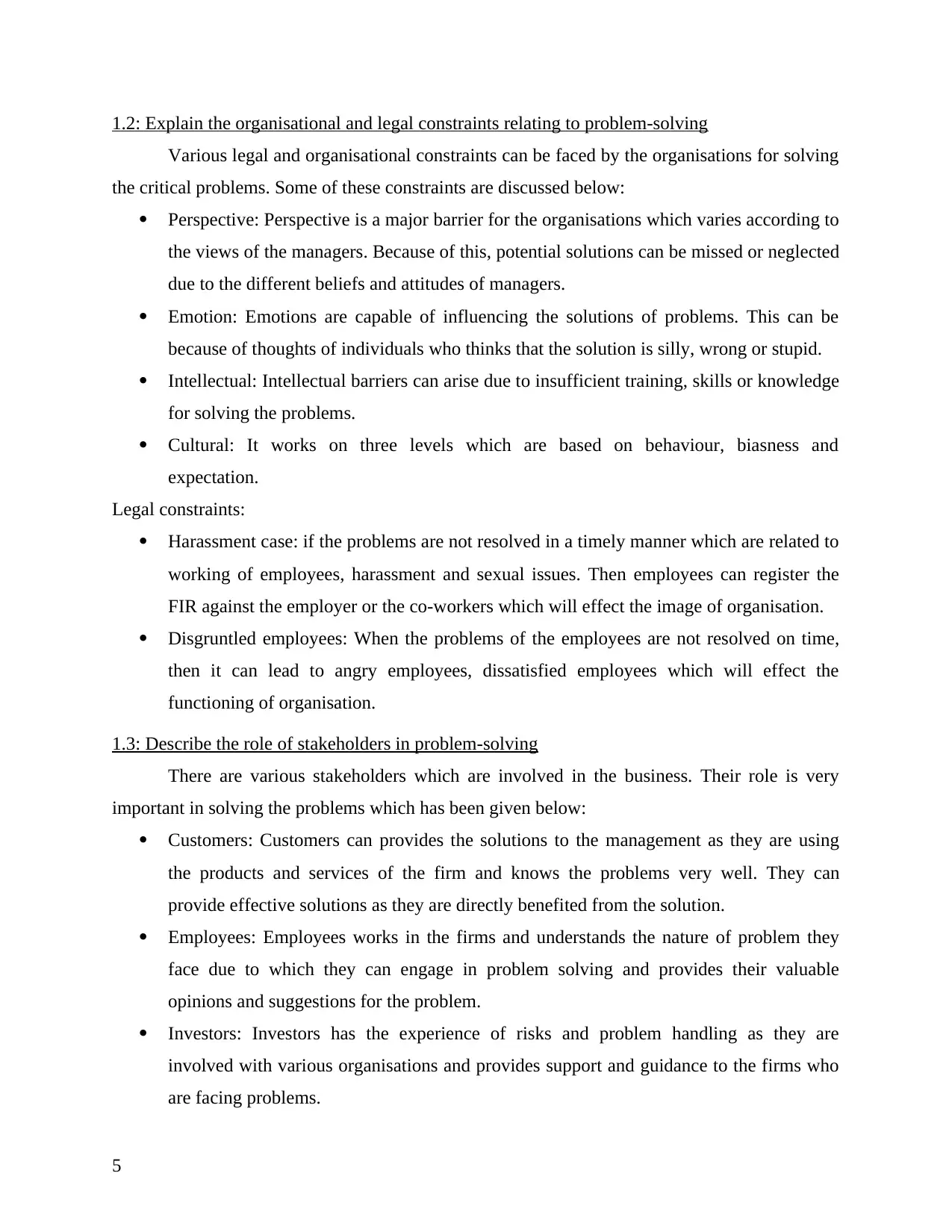
1.2: Explain the organisational and legal constraints relating to problem-solving
Various legal and organisational constraints can be faced by the organisations for solving
the critical problems. Some of these constraints are discussed below:
Perspective: Perspective is a major barrier for the organisations which varies according to
the views of the managers. Because of this, potential solutions can be missed or neglected
due to the different beliefs and attitudes of managers.
Emotion: Emotions are capable of influencing the solutions of problems. This can be
because of thoughts of individuals who thinks that the solution is silly, wrong or stupid.
Intellectual: Intellectual barriers can arise due to insufficient training, skills or knowledge
for solving the problems.
Cultural: It works on three levels which are based on behaviour, biasness and
expectation.
Legal constraints:
Harassment case: if the problems are not resolved in a timely manner which are related to
working of employees, harassment and sexual issues. Then employees can register the
FIR against the employer or the co-workers which will effect the image of organisation.
Disgruntled employees: When the problems of the employees are not resolved on time,
then it can lead to angry employees, dissatisfied employees which will effect the
functioning of organisation.
1.3: Describe the role of stakeholders in problem-solving
There are various stakeholders which are involved in the business. Their role is very
important in solving the problems which has been given below:
Customers: Customers can provides the solutions to the management as they are using
the products and services of the firm and knows the problems very well. They can
provide effective solutions as they are directly benefited from the solution.
Employees: Employees works in the firms and understands the nature of problem they
face due to which they can engage in problem solving and provides their valuable
opinions and suggestions for the problem.
Investors: Investors has the experience of risks and problem handling as they are
involved with various organisations and provides support and guidance to the firms who
are facing problems.
5
Various legal and organisational constraints can be faced by the organisations for solving
the critical problems. Some of these constraints are discussed below:
Perspective: Perspective is a major barrier for the organisations which varies according to
the views of the managers. Because of this, potential solutions can be missed or neglected
due to the different beliefs and attitudes of managers.
Emotion: Emotions are capable of influencing the solutions of problems. This can be
because of thoughts of individuals who thinks that the solution is silly, wrong or stupid.
Intellectual: Intellectual barriers can arise due to insufficient training, skills or knowledge
for solving the problems.
Cultural: It works on three levels which are based on behaviour, biasness and
expectation.
Legal constraints:
Harassment case: if the problems are not resolved in a timely manner which are related to
working of employees, harassment and sexual issues. Then employees can register the
FIR against the employer or the co-workers which will effect the image of organisation.
Disgruntled employees: When the problems of the employees are not resolved on time,
then it can lead to angry employees, dissatisfied employees which will effect the
functioning of organisation.
1.3: Describe the role of stakeholders in problem-solving
There are various stakeholders which are involved in the business. Their role is very
important in solving the problems which has been given below:
Customers: Customers can provides the solutions to the management as they are using
the products and services of the firm and knows the problems very well. They can
provide effective solutions as they are directly benefited from the solution.
Employees: Employees works in the firms and understands the nature of problem they
face due to which they can engage in problem solving and provides their valuable
opinions and suggestions for the problem.
Investors: Investors has the experience of risks and problem handling as they are
involved with various organisations and provides support and guidance to the firms who
are facing problems.
5
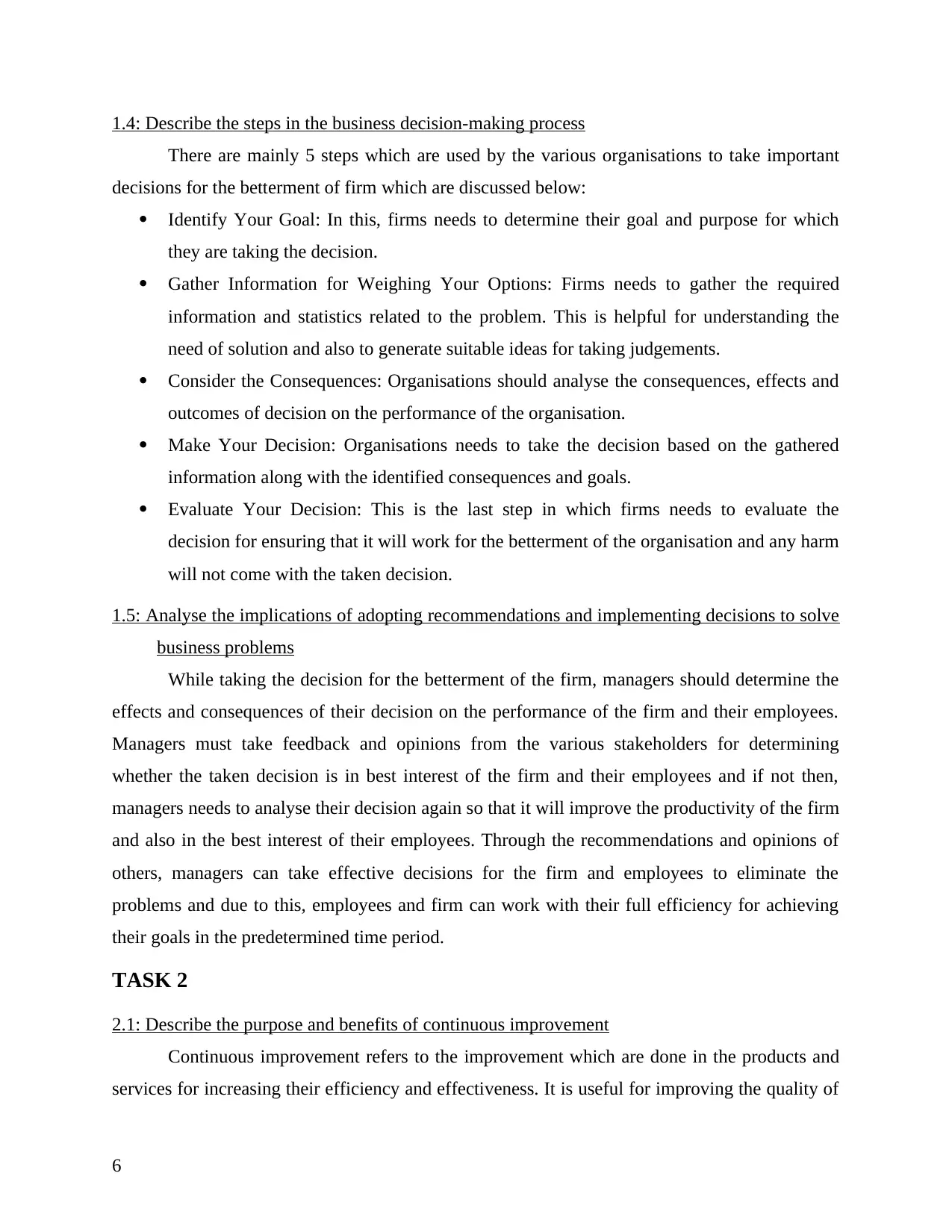
1.4: Describe the steps in the business decision-making process
There are mainly 5 steps which are used by the various organisations to take important
decisions for the betterment of firm which are discussed below:
Identify Your Goal: In this, firms needs to determine their goal and purpose for which
they are taking the decision.
Gather Information for Weighing Your Options: Firms needs to gather the required
information and statistics related to the problem. This is helpful for understanding the
need of solution and also to generate suitable ideas for taking judgements.
Consider the Consequences: Organisations should analyse the consequences, effects and
outcomes of decision on the performance of the organisation.
Make Your Decision: Organisations needs to take the decision based on the gathered
information along with the identified consequences and goals.
Evaluate Your Decision: This is the last step in which firms needs to evaluate the
decision for ensuring that it will work for the betterment of the organisation and any harm
will not come with the taken decision.
1.5: Analyse the implications of adopting recommendations and implementing decisions to solve
business problems
While taking the decision for the betterment of the firm, managers should determine the
effects and consequences of their decision on the performance of the firm and their employees.
Managers must take feedback and opinions from the various stakeholders for determining
whether the taken decision is in best interest of the firm and their employees and if not then,
managers needs to analyse their decision again so that it will improve the productivity of the firm
and also in the best interest of their employees. Through the recommendations and opinions of
others, managers can take effective decisions for the firm and employees to eliminate the
problems and due to this, employees and firm can work with their full efficiency for achieving
their goals in the predetermined time period.
TASK 2
2.1: Describe the purpose and benefits of continuous improvement
Continuous improvement refers to the improvement which are done in the products and
services for increasing their efficiency and effectiveness. It is useful for improving the quality of
6
There are mainly 5 steps which are used by the various organisations to take important
decisions for the betterment of firm which are discussed below:
Identify Your Goal: In this, firms needs to determine their goal and purpose for which
they are taking the decision.
Gather Information for Weighing Your Options: Firms needs to gather the required
information and statistics related to the problem. This is helpful for understanding the
need of solution and also to generate suitable ideas for taking judgements.
Consider the Consequences: Organisations should analyse the consequences, effects and
outcomes of decision on the performance of the organisation.
Make Your Decision: Organisations needs to take the decision based on the gathered
information along with the identified consequences and goals.
Evaluate Your Decision: This is the last step in which firms needs to evaluate the
decision for ensuring that it will work for the betterment of the organisation and any harm
will not come with the taken decision.
1.5: Analyse the implications of adopting recommendations and implementing decisions to solve
business problems
While taking the decision for the betterment of the firm, managers should determine the
effects and consequences of their decision on the performance of the firm and their employees.
Managers must take feedback and opinions from the various stakeholders for determining
whether the taken decision is in best interest of the firm and their employees and if not then,
managers needs to analyse their decision again so that it will improve the productivity of the firm
and also in the best interest of their employees. Through the recommendations and opinions of
others, managers can take effective decisions for the firm and employees to eliminate the
problems and due to this, employees and firm can work with their full efficiency for achieving
their goals in the predetermined time period.
TASK 2
2.1: Describe the purpose and benefits of continuous improvement
Continuous improvement refers to the improvement which are done in the products and
services for increasing their efficiency and effectiveness. It is useful for improving the quality of
6
⊘ This is a preview!⊘
Do you want full access?
Subscribe today to unlock all pages.

Trusted by 1+ million students worldwide
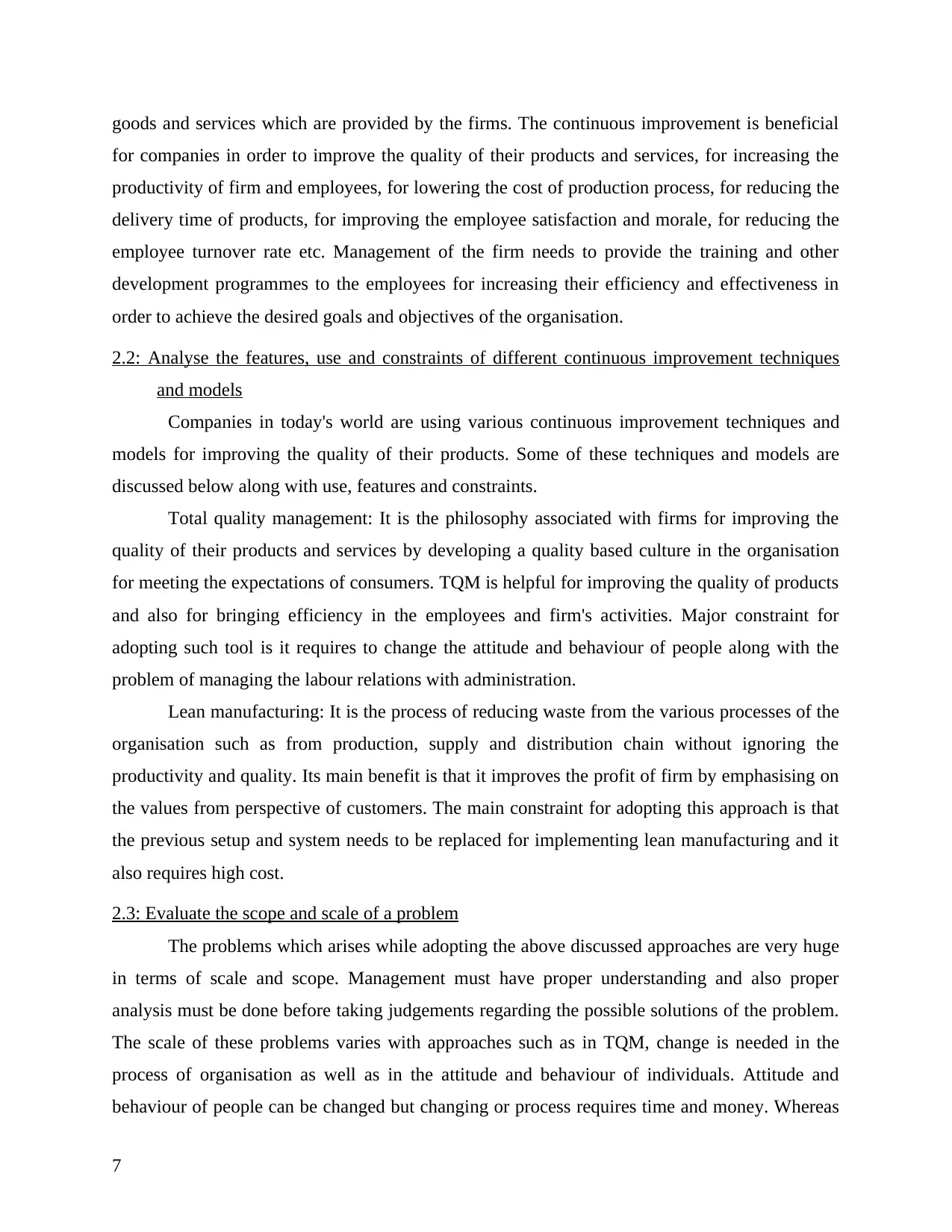
goods and services which are provided by the firms. The continuous improvement is beneficial
for companies in order to improve the quality of their products and services, for increasing the
productivity of firm and employees, for lowering the cost of production process, for reducing the
delivery time of products, for improving the employee satisfaction and morale, for reducing the
employee turnover rate etc. Management of the firm needs to provide the training and other
development programmes to the employees for increasing their efficiency and effectiveness in
order to achieve the desired goals and objectives of the organisation.
2.2: Analyse the features, use and constraints of different continuous improvement techniques
and models
Companies in today's world are using various continuous improvement techniques and
models for improving the quality of their products. Some of these techniques and models are
discussed below along with use, features and constraints.
Total quality management: It is the philosophy associated with firms for improving the
quality of their products and services by developing a quality based culture in the organisation
for meeting the expectations of consumers. TQM is helpful for improving the quality of products
and also for bringing efficiency in the employees and firm's activities. Major constraint for
adopting such tool is it requires to change the attitude and behaviour of people along with the
problem of managing the labour relations with administration.
Lean manufacturing: It is the process of reducing waste from the various processes of the
organisation such as from production, supply and distribution chain without ignoring the
productivity and quality. Its main benefit is that it improves the profit of firm by emphasising on
the values from perspective of customers. The main constraint for adopting this approach is that
the previous setup and system needs to be replaced for implementing lean manufacturing and it
also requires high cost.
2.3: Evaluate the scope and scale of a problem
The problems which arises while adopting the above discussed approaches are very huge
in terms of scale and scope. Management must have proper understanding and also proper
analysis must be done before taking judgements regarding the possible solutions of the problem.
The scale of these problems varies with approaches such as in TQM, change is needed in the
process of organisation as well as in the attitude and behaviour of individuals. Attitude and
behaviour of people can be changed but changing or process requires time and money. Whereas
7
for companies in order to improve the quality of their products and services, for increasing the
productivity of firm and employees, for lowering the cost of production process, for reducing the
delivery time of products, for improving the employee satisfaction and morale, for reducing the
employee turnover rate etc. Management of the firm needs to provide the training and other
development programmes to the employees for increasing their efficiency and effectiveness in
order to achieve the desired goals and objectives of the organisation.
2.2: Analyse the features, use and constraints of different continuous improvement techniques
and models
Companies in today's world are using various continuous improvement techniques and
models for improving the quality of their products. Some of these techniques and models are
discussed below along with use, features and constraints.
Total quality management: It is the philosophy associated with firms for improving the
quality of their products and services by developing a quality based culture in the organisation
for meeting the expectations of consumers. TQM is helpful for improving the quality of products
and also for bringing efficiency in the employees and firm's activities. Major constraint for
adopting such tool is it requires to change the attitude and behaviour of people along with the
problem of managing the labour relations with administration.
Lean manufacturing: It is the process of reducing waste from the various processes of the
organisation such as from production, supply and distribution chain without ignoring the
productivity and quality. Its main benefit is that it improves the profit of firm by emphasising on
the values from perspective of customers. The main constraint for adopting this approach is that
the previous setup and system needs to be replaced for implementing lean manufacturing and it
also requires high cost.
2.3: Evaluate the scope and scale of a problem
The problems which arises while adopting the above discussed approaches are very huge
in terms of scale and scope. Management must have proper understanding and also proper
analysis must be done before taking judgements regarding the possible solutions of the problem.
The scale of these problems varies with approaches such as in TQM, change is needed in the
process of organisation as well as in the attitude and behaviour of individuals. Attitude and
behaviour of people can be changed but changing or process requires time and money. Whereas
7
Paraphrase This Document
Need a fresh take? Get an instant paraphrase of this document with our AI Paraphraser
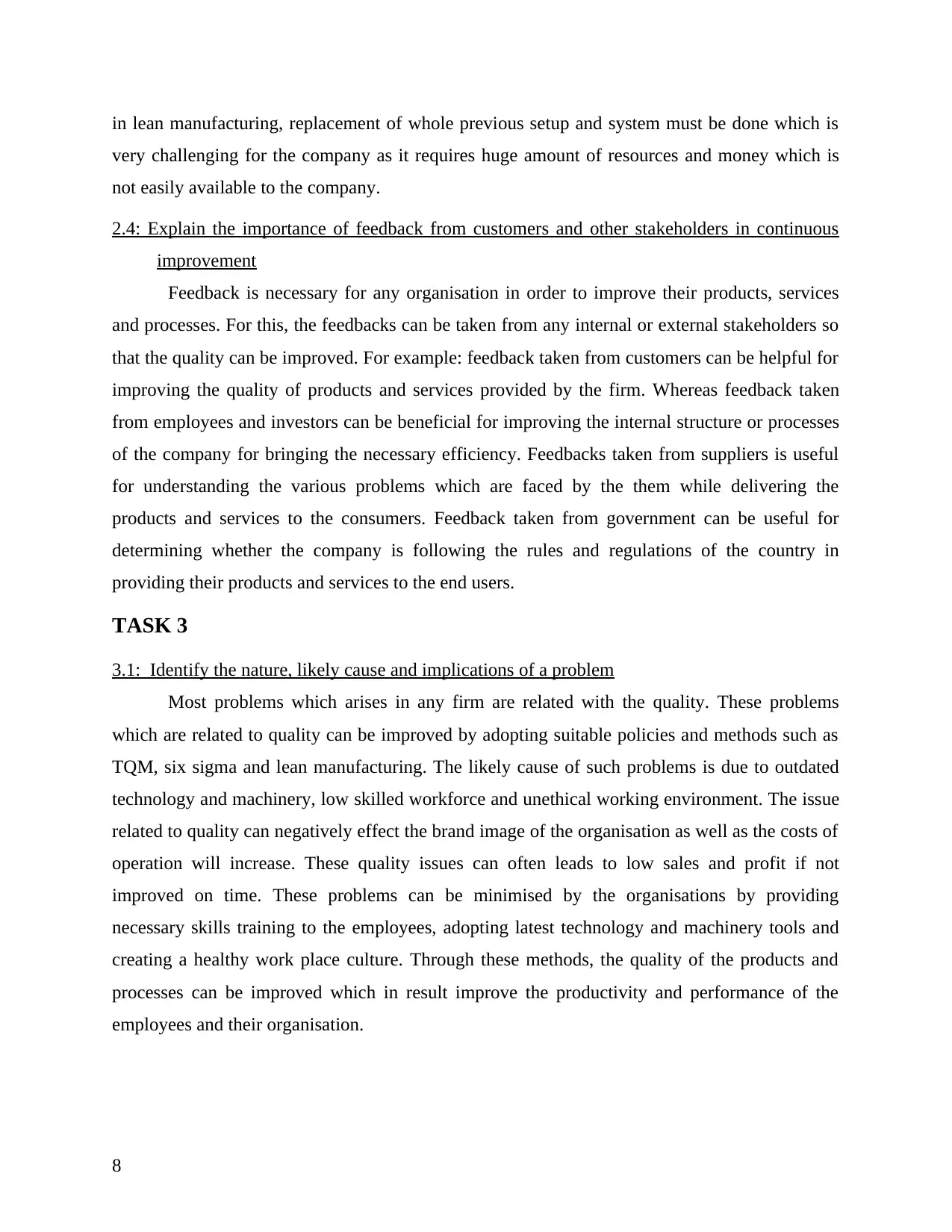
in lean manufacturing, replacement of whole previous setup and system must be done which is
very challenging for the company as it requires huge amount of resources and money which is
not easily available to the company.
2.4: Explain the importance of feedback from customers and other stakeholders in continuous
improvement
Feedback is necessary for any organisation in order to improve their products, services
and processes. For this, the feedbacks can be taken from any internal or external stakeholders so
that the quality can be improved. For example: feedback taken from customers can be helpful for
improving the quality of products and services provided by the firm. Whereas feedback taken
from employees and investors can be beneficial for improving the internal structure or processes
of the company for bringing the necessary efficiency. Feedbacks taken from suppliers is useful
for understanding the various problems which are faced by the them while delivering the
products and services to the consumers. Feedback taken from government can be useful for
determining whether the company is following the rules and regulations of the country in
providing their products and services to the end users.
TASK 3
3.1: Identify the nature, likely cause and implications of a problem
Most problems which arises in any firm are related with the quality. These problems
which are related to quality can be improved by adopting suitable policies and methods such as
TQM, six sigma and lean manufacturing. The likely cause of such problems is due to outdated
technology and machinery, low skilled workforce and unethical working environment. The issue
related to quality can negatively effect the brand image of the organisation as well as the costs of
operation will increase. These quality issues can often leads to low sales and profit if not
improved on time. These problems can be minimised by the organisations by providing
necessary skills training to the employees, adopting latest technology and machinery tools and
creating a healthy work place culture. Through these methods, the quality of the products and
processes can be improved which in result improve the productivity and performance of the
employees and their organisation.
8
very challenging for the company as it requires huge amount of resources and money which is
not easily available to the company.
2.4: Explain the importance of feedback from customers and other stakeholders in continuous
improvement
Feedback is necessary for any organisation in order to improve their products, services
and processes. For this, the feedbacks can be taken from any internal or external stakeholders so
that the quality can be improved. For example: feedback taken from customers can be helpful for
improving the quality of products and services provided by the firm. Whereas feedback taken
from employees and investors can be beneficial for improving the internal structure or processes
of the company for bringing the necessary efficiency. Feedbacks taken from suppliers is useful
for understanding the various problems which are faced by the them while delivering the
products and services to the consumers. Feedback taken from government can be useful for
determining whether the company is following the rules and regulations of the country in
providing their products and services to the end users.
TASK 3
3.1: Identify the nature, likely cause and implications of a problem
Most problems which arises in any firm are related with the quality. These problems
which are related to quality can be improved by adopting suitable policies and methods such as
TQM, six sigma and lean manufacturing. The likely cause of such problems is due to outdated
technology and machinery, low skilled workforce and unethical working environment. The issue
related to quality can negatively effect the brand image of the organisation as well as the costs of
operation will increase. These quality issues can often leads to low sales and profit if not
improved on time. These problems can be minimised by the organisations by providing
necessary skills training to the employees, adopting latest technology and machinery tools and
creating a healthy work place culture. Through these methods, the quality of the products and
processes can be improved which in result improve the productivity and performance of the
employees and their organisation.
8
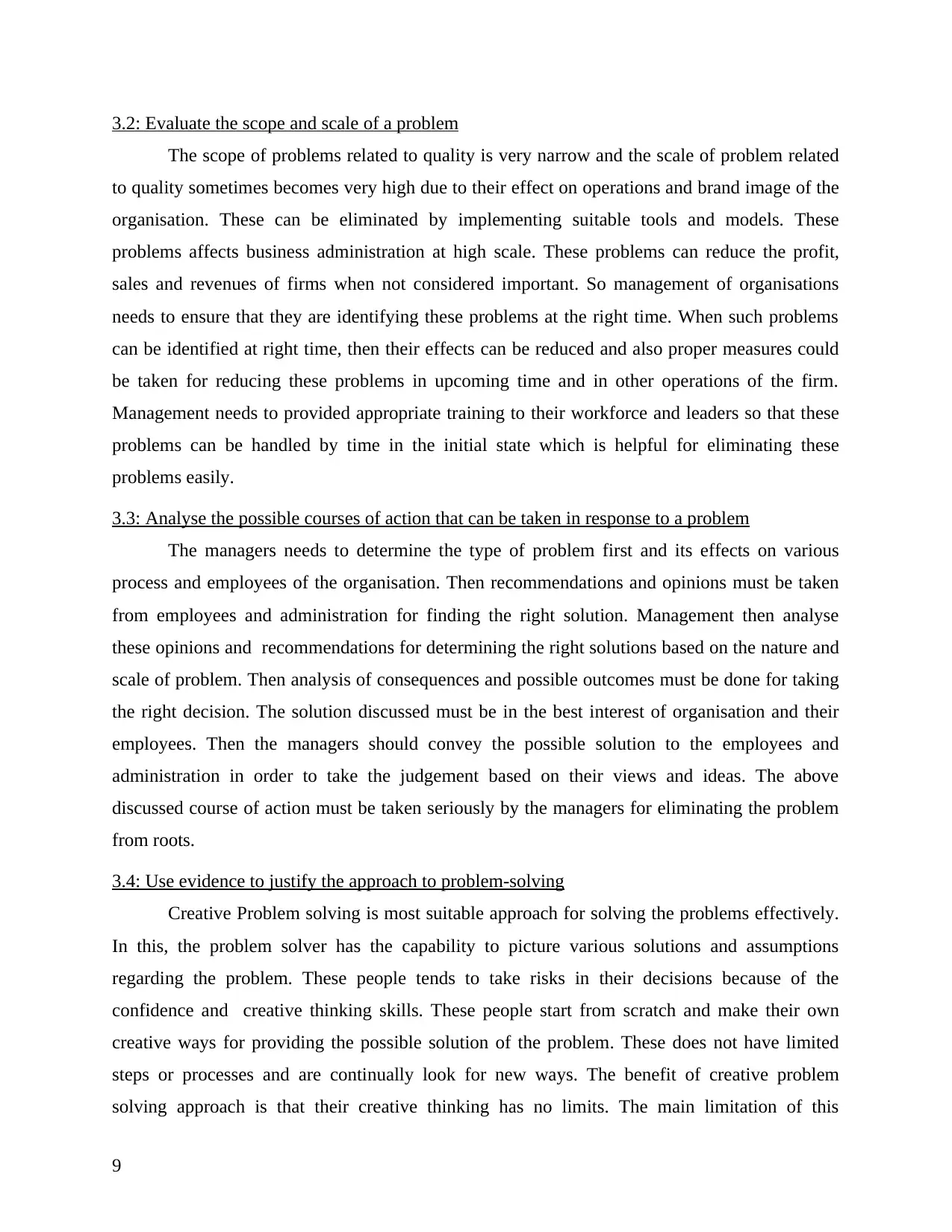
3.2: Evaluate the scope and scale of a problem
The scope of problems related to quality is very narrow and the scale of problem related
to quality sometimes becomes very high due to their effect on operations and brand image of the
organisation. These can be eliminated by implementing suitable tools and models. These
problems affects business administration at high scale. These problems can reduce the profit,
sales and revenues of firms when not considered important. So management of organisations
needs to ensure that they are identifying these problems at the right time. When such problems
can be identified at right time, then their effects can be reduced and also proper measures could
be taken for reducing these problems in upcoming time and in other operations of the firm.
Management needs to provided appropriate training to their workforce and leaders so that these
problems can be handled by time in the initial state which is helpful for eliminating these
problems easily.
3.3: Analyse the possible courses of action that can be taken in response to a problem
The managers needs to determine the type of problem first and its effects on various
process and employees of the organisation. Then recommendations and opinions must be taken
from employees and administration for finding the right solution. Management then analyse
these opinions and recommendations for determining the right solutions based on the nature and
scale of problem. Then analysis of consequences and possible outcomes must be done for taking
the right decision. The solution discussed must be in the best interest of organisation and their
employees. Then the managers should convey the possible solution to the employees and
administration in order to take the judgement based on their views and ideas. The above
discussed course of action must be taken seriously by the managers for eliminating the problem
from roots.
3.4: Use evidence to justify the approach to problem-solving
Creative Problem solving is most suitable approach for solving the problems effectively.
In this, the problem solver has the capability to picture various solutions and assumptions
regarding the problem. These people tends to take risks in their decisions because of the
confidence and creative thinking skills. These people start from scratch and make their own
creative ways for providing the possible solution of the problem. These does not have limited
steps or processes and are continually look for new ways. The benefit of creative problem
solving approach is that their creative thinking has no limits. The main limitation of this
9
The scope of problems related to quality is very narrow and the scale of problem related
to quality sometimes becomes very high due to their effect on operations and brand image of the
organisation. These can be eliminated by implementing suitable tools and models. These
problems affects business administration at high scale. These problems can reduce the profit,
sales and revenues of firms when not considered important. So management of organisations
needs to ensure that they are identifying these problems at the right time. When such problems
can be identified at right time, then their effects can be reduced and also proper measures could
be taken for reducing these problems in upcoming time and in other operations of the firm.
Management needs to provided appropriate training to their workforce and leaders so that these
problems can be handled by time in the initial state which is helpful for eliminating these
problems easily.
3.3: Analyse the possible courses of action that can be taken in response to a problem
The managers needs to determine the type of problem first and its effects on various
process and employees of the organisation. Then recommendations and opinions must be taken
from employees and administration for finding the right solution. Management then analyse
these opinions and recommendations for determining the right solutions based on the nature and
scale of problem. Then analysis of consequences and possible outcomes must be done for taking
the right decision. The solution discussed must be in the best interest of organisation and their
employees. Then the managers should convey the possible solution to the employees and
administration in order to take the judgement based on their views and ideas. The above
discussed course of action must be taken seriously by the managers for eliminating the problem
from roots.
3.4: Use evidence to justify the approach to problem-solving
Creative Problem solving is most suitable approach for solving the problems effectively.
In this, the problem solver has the capability to picture various solutions and assumptions
regarding the problem. These people tends to take risks in their decisions because of the
confidence and creative thinking skills. These people start from scratch and make their own
creative ways for providing the possible solution of the problem. These does not have limited
steps or processes and are continually look for new ways. The benefit of creative problem
solving approach is that their creative thinking has no limits. The main limitation of this
9
⊘ This is a preview!⊘
Do you want full access?
Subscribe today to unlock all pages.

Trusted by 1+ million students worldwide
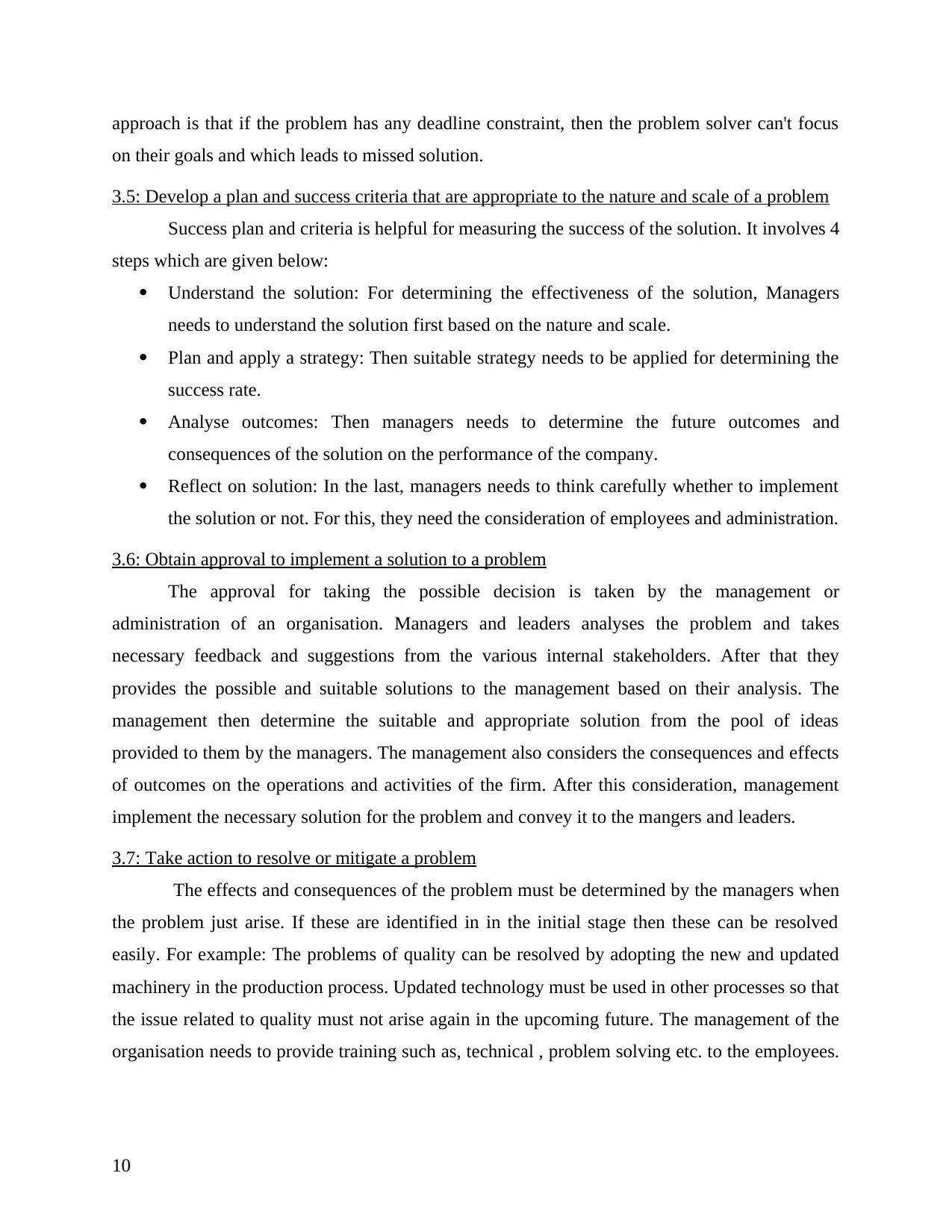
approach is that if the problem has any deadline constraint, then the problem solver can't focus
on their goals and which leads to missed solution.
3.5: Develop a plan and success criteria that are appropriate to the nature and scale of a problem
Success plan and criteria is helpful for measuring the success of the solution. It involves 4
steps which are given below:
Understand the solution: For determining the effectiveness of the solution, Managers
needs to understand the solution first based on the nature and scale.
Plan and apply a strategy: Then suitable strategy needs to be applied for determining the
success rate.
Analyse outcomes: Then managers needs to determine the future outcomes and
consequences of the solution on the performance of the company.
Reflect on solution: In the last, managers needs to think carefully whether to implement
the solution or not. For this, they need the consideration of employees and administration.
3.6: Obtain approval to implement a solution to a problem
The approval for taking the possible decision is taken by the management or
administration of an organisation. Managers and leaders analyses the problem and takes
necessary feedback and suggestions from the various internal stakeholders. After that they
provides the possible and suitable solutions to the management based on their analysis. The
management then determine the suitable and appropriate solution from the pool of ideas
provided to them by the managers. The management also considers the consequences and effects
of outcomes on the operations and activities of the firm. After this consideration, management
implement the necessary solution for the problem and convey it to the mangers and leaders.
3.7: Take action to resolve or mitigate a problem
The effects and consequences of the problem must be determined by the managers when
the problem just arise. If these are identified in in the initial stage then these can be resolved
easily. For example: The problems of quality can be resolved by adopting the new and updated
machinery in the production process. Updated technology must be used in other processes so that
the issue related to quality must not arise again in the upcoming future. The management of the
organisation needs to provide training such as, technical , problem solving etc. to the employees.
10
on their goals and which leads to missed solution.
3.5: Develop a plan and success criteria that are appropriate to the nature and scale of a problem
Success plan and criteria is helpful for measuring the success of the solution. It involves 4
steps which are given below:
Understand the solution: For determining the effectiveness of the solution, Managers
needs to understand the solution first based on the nature and scale.
Plan and apply a strategy: Then suitable strategy needs to be applied for determining the
success rate.
Analyse outcomes: Then managers needs to determine the future outcomes and
consequences of the solution on the performance of the company.
Reflect on solution: In the last, managers needs to think carefully whether to implement
the solution or not. For this, they need the consideration of employees and administration.
3.6: Obtain approval to implement a solution to a problem
The approval for taking the possible decision is taken by the management or
administration of an organisation. Managers and leaders analyses the problem and takes
necessary feedback and suggestions from the various internal stakeholders. After that they
provides the possible and suitable solutions to the management based on their analysis. The
management then determine the suitable and appropriate solution from the pool of ideas
provided to them by the managers. The management also considers the consequences and effects
of outcomes on the operations and activities of the firm. After this consideration, management
implement the necessary solution for the problem and convey it to the mangers and leaders.
3.7: Take action to resolve or mitigate a problem
The effects and consequences of the problem must be determined by the managers when
the problem just arise. If these are identified in in the initial stage then these can be resolved
easily. For example: The problems of quality can be resolved by adopting the new and updated
machinery in the production process. Updated technology must be used in other processes so that
the issue related to quality must not arise again in the upcoming future. The management of the
organisation needs to provide training such as, technical , problem solving etc. to the employees.
10
Paraphrase This Document
Need a fresh take? Get an instant paraphrase of this document with our AI Paraphraser
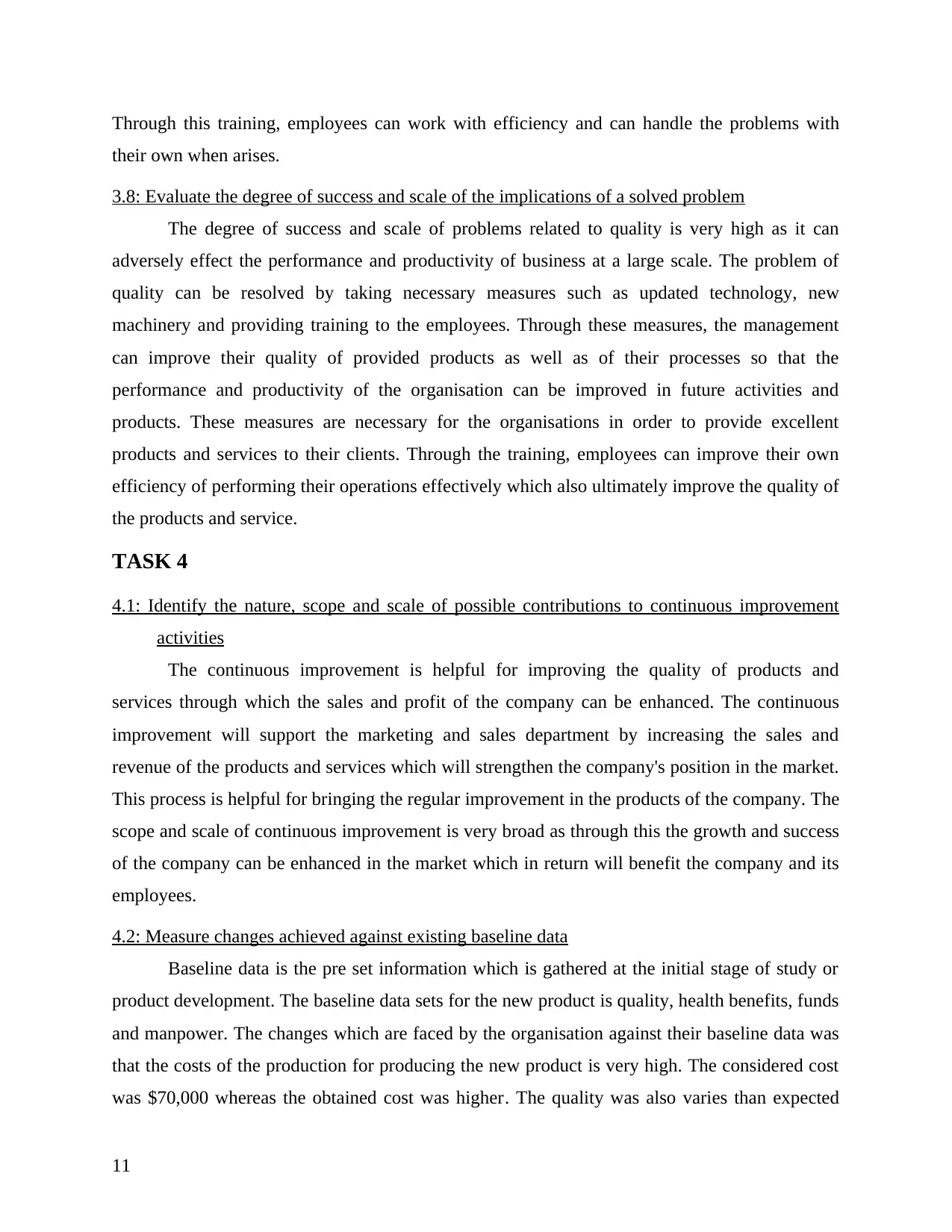
Through this training, employees can work with efficiency and can handle the problems with
their own when arises.
3.8: Evaluate the degree of success and scale of the implications of a solved problem
The degree of success and scale of problems related to quality is very high as it can
adversely effect the performance and productivity of business at a large scale. The problem of
quality can be resolved by taking necessary measures such as updated technology, new
machinery and providing training to the employees. Through these measures, the management
can improve their quality of provided products as well as of their processes so that the
performance and productivity of the organisation can be improved in future activities and
products. These measures are necessary for the organisations in order to provide excellent
products and services to their clients. Through the training, employees can improve their own
efficiency of performing their operations effectively which also ultimately improve the quality of
the products and service.
TASK 4
4.1: Identify the nature, scope and scale of possible contributions to continuous improvement
activities
The continuous improvement is helpful for improving the quality of products and
services through which the sales and profit of the company can be enhanced. The continuous
improvement will support the marketing and sales department by increasing the sales and
revenue of the products and services which will strengthen the company's position in the market.
This process is helpful for bringing the regular improvement in the products of the company. The
scope and scale of continuous improvement is very broad as through this the growth and success
of the company can be enhanced in the market which in return will benefit the company and its
employees.
4.2: Measure changes achieved against existing baseline data
Baseline data is the pre set information which is gathered at the initial stage of study or
product development. The baseline data sets for the new product is quality, health benefits, funds
and manpower. The changes which are faced by the organisation against their baseline data was
that the costs of the production for producing the new product is very high. The considered cost
was $70,000 whereas the obtained cost was higher. The quality was also varies than expected
11
their own when arises.
3.8: Evaluate the degree of success and scale of the implications of a solved problem
The degree of success and scale of problems related to quality is very high as it can
adversely effect the performance and productivity of business at a large scale. The problem of
quality can be resolved by taking necessary measures such as updated technology, new
machinery and providing training to the employees. Through these measures, the management
can improve their quality of provided products as well as of their processes so that the
performance and productivity of the organisation can be improved in future activities and
products. These measures are necessary for the organisations in order to provide excellent
products and services to their clients. Through the training, employees can improve their own
efficiency of performing their operations effectively which also ultimately improve the quality of
the products and service.
TASK 4
4.1: Identify the nature, scope and scale of possible contributions to continuous improvement
activities
The continuous improvement is helpful for improving the quality of products and
services through which the sales and profit of the company can be enhanced. The continuous
improvement will support the marketing and sales department by increasing the sales and
revenue of the products and services which will strengthen the company's position in the market.
This process is helpful for bringing the regular improvement in the products of the company. The
scope and scale of continuous improvement is very broad as through this the growth and success
of the company can be enhanced in the market which in return will benefit the company and its
employees.
4.2: Measure changes achieved against existing baseline data
Baseline data is the pre set information which is gathered at the initial stage of study or
product development. The baseline data sets for the new product is quality, health benefits, funds
and manpower. The changes which are faced by the organisation against their baseline data was
that the costs of the production for producing the new product is very high. The considered cost
was $70,000 whereas the obtained cost was higher. The quality was also varies than expected
11
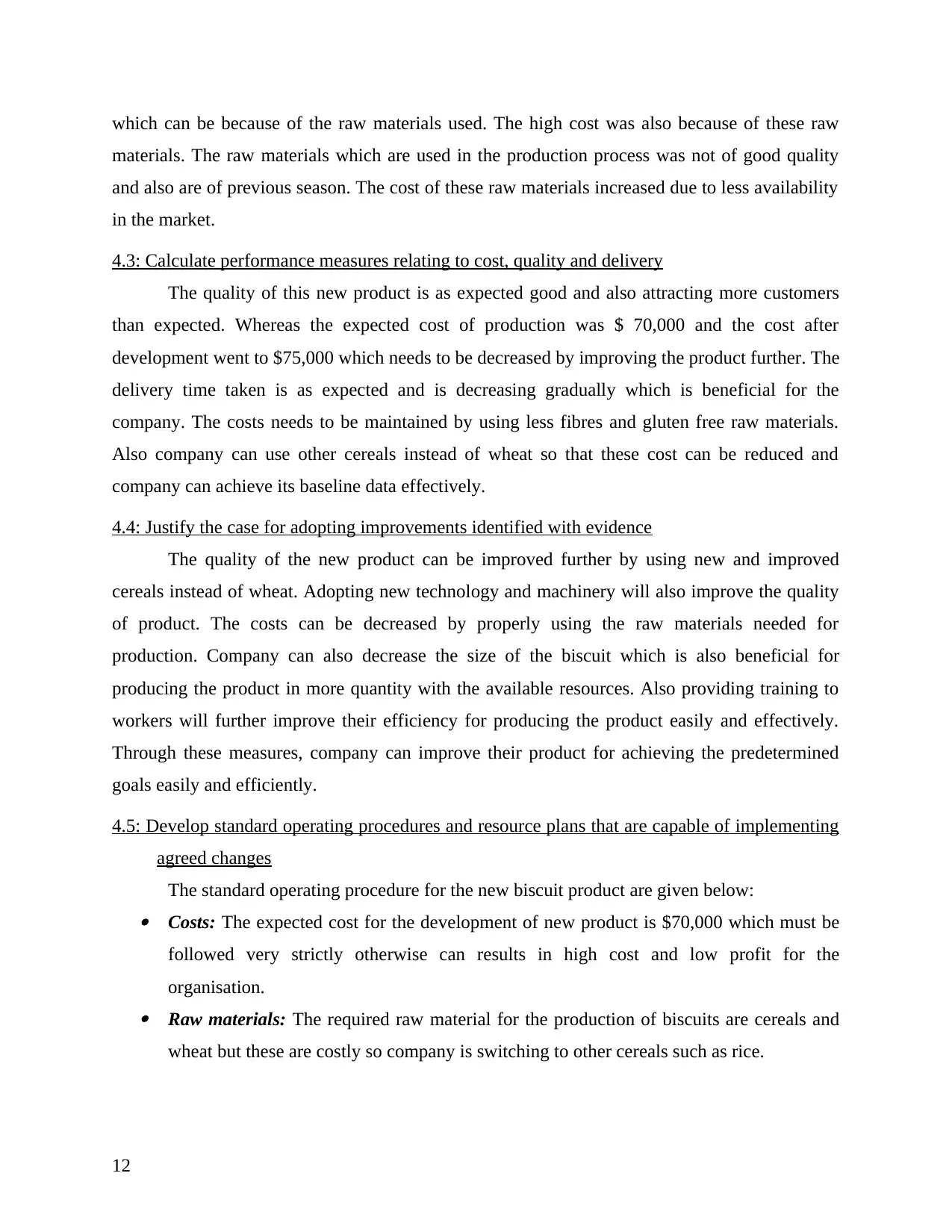
which can be because of the raw materials used. The high cost was also because of these raw
materials. The raw materials which are used in the production process was not of good quality
and also are of previous season. The cost of these raw materials increased due to less availability
in the market.
4.3: Calculate performance measures relating to cost, quality and delivery
The quality of this new product is as expected good and also attracting more customers
than expected. Whereas the expected cost of production was $ 70,000 and the cost after
development went to $75,000 which needs to be decreased by improving the product further. The
delivery time taken is as expected and is decreasing gradually which is beneficial for the
company. The costs needs to be maintained by using less fibres and gluten free raw materials.
Also company can use other cereals instead of wheat so that these cost can be reduced and
company can achieve its baseline data effectively.
4.4: Justify the case for adopting improvements identified with evidence
The quality of the new product can be improved further by using new and improved
cereals instead of wheat. Adopting new technology and machinery will also improve the quality
of product. The costs can be decreased by properly using the raw materials needed for
production. Company can also decrease the size of the biscuit which is also beneficial for
producing the product in more quantity with the available resources. Also providing training to
workers will further improve their efficiency for producing the product easily and effectively.
Through these measures, company can improve their product for achieving the predetermined
goals easily and efficiently.
4.5: Develop standard operating procedures and resource plans that are capable of implementing
agreed changes
The standard operating procedure for the new biscuit product are given below: Costs: The expected cost for the development of new product is $70,000 which must be
followed very strictly otherwise can results in high cost and low profit for the
organisation. Raw materials: The required raw material for the production of biscuits are cereals and
wheat but these are costly so company is switching to other cereals such as rice.
12
materials. The raw materials which are used in the production process was not of good quality
and also are of previous season. The cost of these raw materials increased due to less availability
in the market.
4.3: Calculate performance measures relating to cost, quality and delivery
The quality of this new product is as expected good and also attracting more customers
than expected. Whereas the expected cost of production was $ 70,000 and the cost after
development went to $75,000 which needs to be decreased by improving the product further. The
delivery time taken is as expected and is decreasing gradually which is beneficial for the
company. The costs needs to be maintained by using less fibres and gluten free raw materials.
Also company can use other cereals instead of wheat so that these cost can be reduced and
company can achieve its baseline data effectively.
4.4: Justify the case for adopting improvements identified with evidence
The quality of the new product can be improved further by using new and improved
cereals instead of wheat. Adopting new technology and machinery will also improve the quality
of product. The costs can be decreased by properly using the raw materials needed for
production. Company can also decrease the size of the biscuit which is also beneficial for
producing the product in more quantity with the available resources. Also providing training to
workers will further improve their efficiency for producing the product easily and effectively.
Through these measures, company can improve their product for achieving the predetermined
goals easily and efficiently.
4.5: Develop standard operating procedures and resource plans that are capable of implementing
agreed changes
The standard operating procedure for the new biscuit product are given below: Costs: The expected cost for the development of new product is $70,000 which must be
followed very strictly otherwise can results in high cost and low profit for the
organisation. Raw materials: The required raw material for the production of biscuits are cereals and
wheat but these are costly so company is switching to other cereals such as rice.
12
⊘ This is a preview!⊘
Do you want full access?
Subscribe today to unlock all pages.

Trusted by 1+ million students worldwide
1 out of 14
Related Documents
Your All-in-One AI-Powered Toolkit for Academic Success.
+13062052269
info@desklib.com
Available 24*7 on WhatsApp / Email
![[object Object]](/_next/static/media/star-bottom.7253800d.svg)
Unlock your academic potential
Copyright © 2020–2025 A2Z Services. All Rights Reserved. Developed and managed by ZUCOL.





